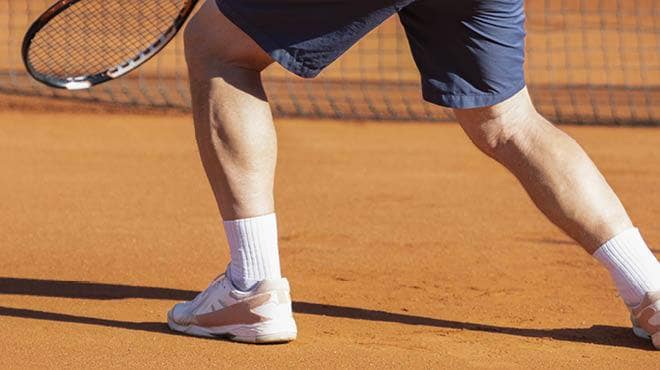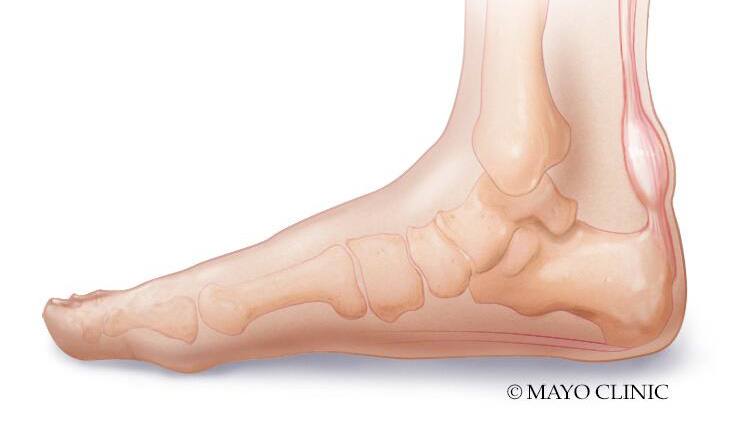Diagnosis
During the physical exam, your doctor will gently press on the affected area to determine the location of pain, tenderness or swelling. He or she will also evaluate the flexibility, alignment, range of motion and reflexes of your foot and ankle.
Imaging tests
Your doctor may order one or more of the following tests to assess your condition:
- X-rays. While X-rays can't visualize soft tissues such as tendons, they may help rule out other conditions that can cause similar symptoms.
- Ultrasound. This device uses sound waves to visualize soft tissues like tendons. Ultrasound can also produce real-time images of the Achilles tendon in motion, and color-Doppler ultrasound can evaluate blood flow around the tendon.
- Magnetic resonance imaging (MRI). Using radio waves and a very strong magnet, MRI machines can produce very detailed images of the Achilles tendon.
Treatment
Tendinitis usually responds well to self-care measures. But if your signs and symptoms are severe or persistent, your doctor might suggest other treatment options.
- Medications
-
If over-the-counter pain medications — such as ibuprofen (Advil, Motrin IB, others) or naproxen (Aleve) — aren't enough, your doctor might prescribe stronger medications to reduce inflammation and relieve pain.
- Physical therapy
-
A physical therapist might suggest some of the following treatment options:
-
Exercises. Therapists often prescribe specific stretching and strengthening exercises to promote healing and strengthening of the Achilles tendon and its supporting structures.
A special type of strengthening called "eccentric" strengthening, involving a slow let down of a weight after raising it, has been found to be especially helpful for persistent Achilles problems.
- Orthotic devices. A shoe insert or wedge that slightly elevates your heel can relieve strain on the tendon and provide a cushion that lessens the amount of force exerted on your Achilles tendon.
-
- Surgery
-
If several months of more-conservative treatments don't work or if the tendon has torn, your doctor may suggest surgery to repair your Achilles tendon.
From Mayo Clinic to your inbox
Self care
Self-care strategies include the following steps, often known by the acronym R.I.C.E.:
- Rest. You may need to avoid exercise for several days or switch to an activity that doesn't strain the Achilles tendon, such as swimming. In severe cases, you may need to wear a walking boot and use crutches.
- Ice. To decrease pain or swelling, apply an ice pack to the tendon for about 15 minutes after exercising or when you experience pain.
- Compression. Wraps or compressive elastic bandages can help reduce swelling and reduce movement of the tendon.
- Elevation. Raise the affected foot above the level of your heart to reduce swelling. Sleep with your affected foot elevated at night.
Preparing for your appointment
You'll likely first bring your symptoms to the attention of your family doctor. He or she might refer you to a doctor specializing in sports medicine or physical and rehabilitative medicine (physiatrist). If your Achilles tendon has ruptured, you may need to see an orthopedic surgeon.
What you can do
Before your appointment, you may want to write a list of answers to the following questions:
- Did the pain begin suddenly or gradually?
- Are symptoms worse at certain times of day or after certain activities?
- What types of shoes do you wear during exercise?
- What medications and supplements do you take regularly?
What to expect from your doctor
Be prepared to answer the following questions regarding your symptoms and factors that may be contributing to your condition:
- Where exactly does it hurt?
- Does the pain lessen with rest?
- What is your normal exercise routine?
- Have you recently made changes to your exercise routine, or have you recently started participating in a new sport?
- What have you done for pain relief?

